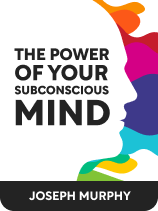

This article is an excerpt from the Shortform book guide to "The Power of Your Subconscious Mind" by Joseph Murphy. Shortform has the world's best summaries and analyses of books you should be reading.
Like this article? Sign up for a free trial here .
What is the difference between the conscious and the subconscious mind? How much of the brain activity takes place in your subconscious? How do the conscious and the subconscious minds interact?
Your mind is made up of two parts: the conscious mind and the subconscious mind. Over 90% of your brain’s activity takes place in your subconscious mind—it’s a reservoir of thoughts, feelings, and memories that lies beneath your conscious awareness. Your conscious mind contains all of the thoughts and feelings that you’re aware of at any given moment.
In this article, we’ll explore each part individually and how they interact.
Your Conscious Mind
Murphy explains that your conscious mind is your active mind. You use it to judge your environment and to make choices and decisions based on these judgments.
(Shortform note: Research backs up Murphy’s judgment of the conscious mind as your active mind. According to Brian Tracy (Eat That Frog!), your conscious mind continually identifies, compares, and analyzes all of the information you perceive so that it can make decisions about what is relevant to you. However, Tracy notes that your conscious mind functions like a binary computer—it has no memory and can only think one thought at a time.)
Your Subconscious Mind
Murphy explains that your subconscious mind is your passive mind. It’s always awake because it regulates all of your bodily functions, and it records and stores your every experience, even when you’re not consciously paying attention.
(Shortform note: There is still much to be learned about how the subconscious mind works, but even in 1963, Murphy was right about its importance—neuroscientists have confirmed that 95% of your brain activity takes place beyond your conscious awareness, in your subconscious mind. Further, research reveals that your subconscious mind makes decisions about how you choose to feel or act before your conscious mind even perceives the need to make a decision.)
Your Habitual Thoughts Imprint Upon Your Subconscious Mind
Murphy claims that your subconscious mind is impersonal because it passively accepts your habitual conscious thoughts without question. In other words, it doesn’t judge any of your conscious thoughts (in the same way that your computer doesn’t judge the documents you save onto your hard drive). All of the thoughts you think in your conscious mind filter down into your subconscious mind and leave an impression. The more often you think certain thoughts, the heavier the impression you leave on your subconscious mind.
According to Murphy, the way your conscious thoughts imprint upon and mold your subconscious mind determines your personality traits and how you respond to your life experiences. This is because your habitual thoughts train your subconscious mind to create associations and shortcuts between all of the thoughts, feelings, and experiences it has stored.
To clarify how your conscious and subconscious mind interact, we’ll first explore the process that enables you to use subconscious shortcuts to perform certain tasks automatically. Then, we’ll explore how, according to Murphy, this same process influences your feelings, behaviors, and personality.
Your Subconscious Mind Learns From Repetition
Murphy explains that you’re able to perform tasks without having to apply conscious thought, such as riding a bike or getting dressed, because the impressions your habitual conscious thoughts make condition your subconscious mind to act automatically. When you’re learning how to do something new, you have to focus on what you’re doing and apply conscious effort in order to do it right. The more you practice this skill, the easier it becomes for you to perform the task without conscious effort. This is because your subconscious mind learns how to perform the task and takes control so that you can perform it automatically.
Your Subconscious Mind Forms Conclusions About Your Beliefs
In the same way that practicing a new skill conditions you to carry it out automatically, your habitual conscious thoughts condition your subconscious mind to identify and classify everything it perceives in a specific way. For example, if you habitually think that dogs are a threat, your subconscious mind classifies every dog it perceives as a threat. Murphy claims that this is because your subconscious mind forms conclusions about what your overarching beliefs are based on your habitual conscious thoughts. It then automatically relies upon these overarching beliefs to process and catalog all of the information it records.
The following examples illustrate how your subconscious mind creates conclusions from your overarching beliefs:
Example #1: You habitually think that “men are distrustful” and imprint this upon your subconscious mind. Your thoughts turn into a belief—your subconscious mind concludes that every man you think of or see is distrustful: “Men are distrustful, this is a man, therefore he is distrustful.”
Example #2: You habitually think about how uncomfortable you feel around strangers and imprint this into your subconscious mind. These thoughts turn into a belief so your subconscious mind concludes that every new person threatens your sense of safety and comfort: “Strangers make me uncomfortable, this is a new person, therefore I should feel uncomfortable.”

———End of Preview———
Like what you just read? Read the rest of the world's best book summary and analysis of Joseph Murphy's "The Power of Your Subconscious Mind" at Shortform .
Here's what you'll find in our full The Power of Your Subconscious Mind summary :
- How your subconscious mind creates your life experiences
- How to improve your life experiences by using your conscious mind to influence your subconscious
- Why we're all designed to experience happiness






